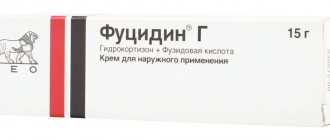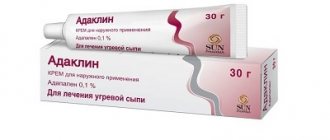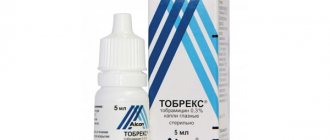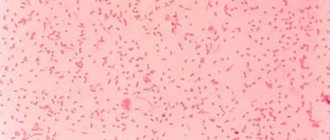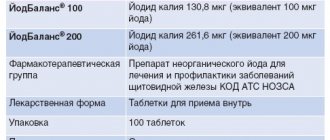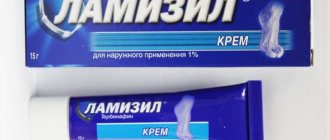With the modern rhythm of life, people constantly need medications - harmful external influences on the human body constantly provoke infections and skin diseases, which cannot be ignored.
Fucidin, ointment and cream, is one of the most popular combination drugs that helps in the treatment of bacteriological inflammation of the skin. A long-term reputation confirms the effectiveness of this drug; over the years of its existence on the Russian pharmacological market, Fucidin G has proven itself to be excellent.
pharmachologic effect
Fucidin G is a combination drug for external use. Combines the anti-inflammatory and antipruritic effects of hydrocortisone with the antibacterial effect of fusidic acid.
Highly active against: Staphylococcus spp, especially Staphylococcus aureus and Staphylococcus epidermidis (including methicillin-resistant strains); Streptococcus spp, Neisseria spp, Clostridium spp, Nocardia asteroides, Enterococcus spp, Bacteroides spp, Mycobacterium tuberculosis, Mycobacterium leprae, Corynebacterium minutissimum. The antibacterial activity of fusidic acid is not reduced in the presence of hydrocortisone.
Reviews
“For me, Fucidin has become a real salvation from severe acne. Despite the fact that I had long since passed adolescence, most of my face, back and shoulders were constantly covered with annoying pimples - of course, my appearance left much to be desired. When I was examined by doctors, they told me that acne was caused by hormonal imbalance and prescribed the hormonal cream Fucidin G. I noticed the effect after just a few uses, and a week after I started using the drug regularly, the number of acne decreased significantly! I hope that over time the cream will help me get rid of them completely.” Anna, 26 years old.
“I had a skin injury on my arm and after it got infected, I developed a purulent infection that looked bad and caused a lot of pain. I started using Fucidin ointment along with a gauze bandage - I applied it twice a day. After a week, the inflammation decreased significantly, as did my pain - thanks to this effectiveness of the drug, I am quickly on the mend, and will continue to use the ointment to completely eliminate the inflammatory process.” Vladimir, 30 years old.
Use during pregnancy and breastfeeding
Experimental studies have shown that Fucidin G does not have embryotoxic or teratogenic effects. When Fucidin G is used externally, the release of both fusidic acid and hydrocortisone into breast milk is unlikely due to low systemic adsorption. Since no studies have been conducted in women during pregnancy and lactation, the drug should not be used for a long time or in large quantities during pregnancy; during breastfeeding, the drug should not be applied to the mammary glands.
Application
Like all medications sold on pharmacy shelves, all packages of Fucidin cream and ointment have included instructions for use, which detail all the rules and dosages for the correct use of the drug and the greatest effectiveness. A short version of these instructions is available for review below.
Application of Fucidin cream
Apply a small amount to the affected skin area in a thin layer and spread evenly over the surface. The frequency of application is 3-4 times a day, depending on the severity of inflammation.
The hormonal form of the drug, Fucidin G, is not recommended by doctors for use by pregnant and breastfeeding women. Despite the fact that this is not a direct contraindication, during this period the effect of the hormone cortisone on the female body is undesirable.
Use of Fucidin ointment
Recommendations for the use of Fucidin ointment are almost the same as those offered for the cream. The ointment is also recommended to be applied to the affected areas of the skin and spread in an even thin layer several times a day. However, since this form of release is not hormonal, it is suitable for use by women during pregnancy and lactation - that is, there are fewer contraindications to the use of Fucidin ointment.
Fucidin - what is it?
Before undertaking treatment, it is worth understanding what kind of drug Fucidin is. This is a strong modern antibiotic designed to fight viral bacteria on the skin. Its composition destroys the protein produced by pathogens, causing them to die. Both forms of this cream are white, odorless, and packaged in tubes of 15 g each.
Fucidin cream - composition
To ensure that the drug does not lose its properties, it must be stored correctly, the optimal temperature is up to 25C. Many patients are concerned about the question: is Fucidin cream hormonal or not? Regular cream does not contain hormones, but Fucidin G contains it, which must be taken into account when choosing. The effects and indications of the creams are the same, as is the composition, only Fucidin G contains hydrocortisone.
Fucidin components:
- fusidic acid;
- alcohol;
- glycerol;
- paraffins – liquid and soft white;
- polysorbate;
- hydrochloric acid;
- potassium sorbate;
- butylated hydroxyanisole.
What is Fucidin cream used for?
The main purpose of the cream is infectious skin diseases, but it only helps with viruses that are sensitive to fusidic acid. Therefore, it is very important to first clearly determine the type of virus; in such cases, doctors prescribe tests. There is no point in using this medicine against a fungal infection. The course of treatment is prescribed for up to 2 weeks, if necessary, continued after a break or the drug is changed. The reason for this is antibiotic resistance in the patient; this reaction is typical for all drugs in this group.
What Fucidin cream helps with:
- infectious dermatitis;
- eczema;
- carbuncles;
- boils;
- ulcers, skin ulcers.
What is the difference between Fucidin cream and ointment?
When purchasing, there is a reason to consider all forms of the drug; some patients ask the question: Fucidin ointment or cream - which is better? They differ only in the thickness of the mixture and shade, and if we consider Fucidin G, then in composition. The indications and side effects of regular cream and ointment are identical, but the hormonal composition has additional contraindications.
What is the difference between Fucidin cream and ointment:
- The ointment is more viscous and thick, translucent, yellowish in color.
- The cream retains its white color and is absorbed faster.
- Ointment creates a protective film on the skin, but cream does not.
- The ointment is used during exacerbation of the disease.
- The cream is recommended in the initial stages of the disease.
Cream Fucidin - analogues
Fucidin cream helps with streptoderma, which is an infectious skin lesion with the release of pus. The causative agents of the disease are streptococci; if measures are taken, inflammation can spread to internal organs, since these pathogens destroy tissue and blood cells. In this case, an ointment is considered more effective, rather than a cream, or Fucidin G, which copes with inflammation faster and more effectively.
If the drug is not suitable, you can choose Fusiderm, it is also based on fusidic acid, but the excipients are different: glycerol, paraffin, potassium sorbate, polysorbate, petrolatum, butylated hydroxyanisole. The only contraindications are sensitivity to the components. If you are allergic to the main substance, the medicine is chosen from those that are suitable for its effect, and not for its composition.
Analogues of Fucidin:
- Gentamicin ointment.
It copes with bacterial infections; it contains gentamicin sulfate, supplemented with paraffin and petroleum jelly. - Baneocin ointment.
Combines 2 strong antibiotics – neomycin and bacitracin, which enhance each other’s effect. Destroys, like Fucidin, gram-positive bacteria and cocci.
Fucidin cream - contraindications
Doctors especially emphasize that Fucidin should not be applied to open wounds and mucous membranes; if the medicine gets into the eyes, they must be washed immediately. Before use, it is necessary to test the drug for tolerability, especially with regard to hormonal composition. To do this, apply a little ointment on the wrist and wait 2-3 hours; if there is no itching or redness, the medicine can be used.
Fucidin cream has the following contraindications:
- fungal infection;
- lupus;
- herpes;
- chicken pox;
- syphilis;
- liver diseases;
- age up to one year.
Due to the hormonal substance, Fucidin G cream cannot be used in children under 2 years of age, and the list of contraindications is supplemented by:
- perioral dermatitis;
- rosacea.
If the drug is abused, side effects may occur, in which case the medication must be changed. Characteristic symptoms:
- allergic rashes;
- conjunctivitis;
- hives, itching.
Synonyms of nosological groups
| Category ICD-10 | Synonyms of diseases according to ICD-10 |
| L20 Atopic dermatitis | Allergic skin diseases |
| Allergic skin diseases of non-infectious etiology | |
| Allergic skin diseases of non-microbial etiology | |
| Allergic skin diseases | |
| Allergic skin lesions | |
| Allergic manifestations on the skin | |
| Allergic dermatitis | |
| Allergic dermatosis | |
| Allergic diathesis | |
| Allergic pruritic dermatosis | |
| Allergic skin disease | |
| Allergic skin irritation | |
| Allergic dermatitis | |
| Atopic dermatitis | |
| Allergic dermatosis | |
| Exudative diathesis | |
| Itchy atopic eczema | |
| Pruritic allergic dermatosis | |
| Skin allergic disease | |
| Skin allergic reaction to drugs and chemicals | |
| Skin reaction to medications | |
| Skin allergic disease | |
| Acute eczema | |
| Common neurodermatitis | |
| Chronic atopic dermatitis | |
| Exudative diathesis | |
| L20.8 Other atopic dermatitis | Allergic eczema |
| Atopic eczema | |
| Dermatosis of neurogenic origin | |
| Childhood eczema | |
| Diffuse neurodermatitis | |
| Constitutional neurodermatitis | |
| Neurodermatitis | |
| Neurodermatoses | |
| Neurodermatitis | |
| Neurodermatitis diffuse | |
| Neurodermatitis limited | |
| Neurodermatitis | |
| Limited neurodermatitis | |
| Chronic neurodermatitis | |
| L21 Seborrheic dermatitis | Seborrheic dermatitis |
| Increased sebum secretion | |
| Seborrheic eczema | |
| Seborrheic dermatitis of the scalp | |
| Seborrheic pyodermatitis | |
| Seborrhea | |
| Seborrheic eczema | |
| L23 Allergic contact dermatitis | Allergic dermatitis |
| Purulent allergic dermatopathies | |
| Contact allergic reaction | |
| Allergic contact dermatitis | |
| Contact allergic dermatitis | |
| Photoallergic contact dermatitis | |
| L30.0 Coin-shaped eczema | Coin dermatitis |
| Nummular dermatitis | |
| Eczema vulgaris | |
| Eczema coin-shaped | |
| L30.3 Infectious dermatitis | Erythema migrans |
| Bacterial dermatitis | |
| Secondarily infected dermatoses | |
| Secondarily infected dermatosis | |
| Secondarily infected dermatoses | |
| Secondarily infected dermatitis | |
| Infectious dermatitis | |
| Infected dermatitis | |
| Dermatitis with associated bacterial infections | |
| Dermatitis in the presence of a bacterial infection or suspicion of it | |
| Dermatoses complicated by secondary infection | |
| Dermatoses complicated by primary and secondary infection | |
| Dermatoses complicated by primary and/or secondary infection | |
| Infected eczema | |
| Infected eczema of the external auditory canal | |
| Infected dermatitis | |
| Infected dermatosis | |
| Erythema migrans | |
| Microbial eczema | |
| Microbial skin infections | |
| Necrolytic migratory erythema | |
| Superinfectious dermatitis | |
| Chronic migratory erythema | |
| Eczema infected | |
| Erythema migrans | |
| Erythema migrans chronic | |
| L30.8 Other specified dermatitis | Angiokeratoma |
| Angiokeratoma diffuse of the trunk | |
| Skin aurantiasis | |
| Darier's disease | |
| Ochrodermatosis | |
| Follicular dyskeratosis | |
| Darier's follicular dyskeratosis | |
| Chronic hand dermatitis | |
| Acrodermatitis enteropathica |
The differences between the drugs are in the forms of release. Fucidin is available in the form of tablets, powder for injection, ointment and cream. G is produced only in the form of a cream. Fucidin has a larger list of indications, because it is taken not only externally, but also internally. It treats many infectious and inflammatory diseases. G treats only skin infections and inflammations. There are some differences in contraindications and side effects.
Adverse reactions with Fucidin are rare, the following are noted:
- skin rashes;
- eczema;
- irritation;
- hives;
- dermatitis.
When prescribing eye ointment, irritation may occur. For intravenous and internal use:
- nausea;
- vomit;
- spasm of veins;
- thrombosis;
- anaphylactic shock;
- increased fatigue;
- asthenic syndrome;
- drowsiness.
Side effects of Fucidin G are:
- skin irritation;
- itching;
- swelling;
- eczema;
- dry skin;
- manifestations of skin allergies;
- hives.
The coordination of Fucidin G cream with other pharmaceuticals has not been studied.
Fucidin cream - indications for use
Fucidin G cream is prescribed in difficult cases; the combination of fusidic acid with the hormone is a very powerful antibacterial mixture. The drug is prescribed for atopic dermatitis, complex skin infections, purulent rashes, large acne on the face, if the cause is hormonal changes in the body, for which Fucidin is used
.
Regular Fucidin cream has identical indications to ointments, except for the listed diseases, it is also used for:
- impetigo;
- hidradenitis;
- folliculitis;
- paronychia;
- sycosis;
- barley, blepharitis;
- keratitis.
Composition and release form
The Irish manufacturer produces Fucidin in two dosage forms. This is a transparent yellowish ointment and white cream with a dense, thick consistency. They are packaged in 15.0 g aluminum tubes with a screw cap. Each package is enclosed in a flat cardboard box along with instructions for use. The active ingredient of 2% of the products is fusidic acid from the group of antibiotics.
The drug is packaged in 15 g. And the auxiliary composition of the ointment is represented by the following components:
- liquid and soft paraffins;
- lanolin;
- cetyl alcohol.
The composition of the additional ingredients of the cream is more diverse. To form the base, the manufacturer also used glycerol, potassium sorbate, hydrochloric acid, butylated hydroxyanisole, and water. Auxiliary components soften and moisturize the skin, promote rapid penetration of fusidic acid into inflamed tissues.
The therapeutic line also includes Fucidin G cream. In addition to fusidic acid, it contains the glucocorticosteroid hydrocortisone. This is a synthetic analogue of hormones that are produced by the adrenal cortex. Therefore, Fucidin G has a powerful anti-inflammatory effect and is used to treat severe diseases.
A drug with an additional component
Pharmacological properties
Fucidin ointment has a bactericidal and bacteriostatic effect. Its effectiveness is based on the properties of the active ingredient. Fusidic acid quickly penetrates into inflammatory lesions. It blocks enzymes that stimulate the production of ergosterols, structural elements of bacterial cells. They gradually lose their integrity and collapse. The ability of fusidic acid to prevent chain elongation of bacterial DNA has also been noted. Pathogenic microorganisms cannot reproduce in such conditions, which leads to their death.
After several days of using Fucidin ointment and cream, the skin condition improves significantly:
- inflammatory processes slow down and then stop;
- the severity of itching, burning, and pain decreases;
- swelling resolves;
- damaged tissues are restored by accelerating blood circulation.
The drug is active against Staphylococcus aureus and Staphylococcus epidermidis, Clostridia, Pseudomonas, and Streptococcus. E. coli, herpes viruses, yeast-like fungi, and all types of protozoa are not sensitive to fusidic acid.
We recommend
Baneocin ointment - instructions for use for the treatment of eczema.
